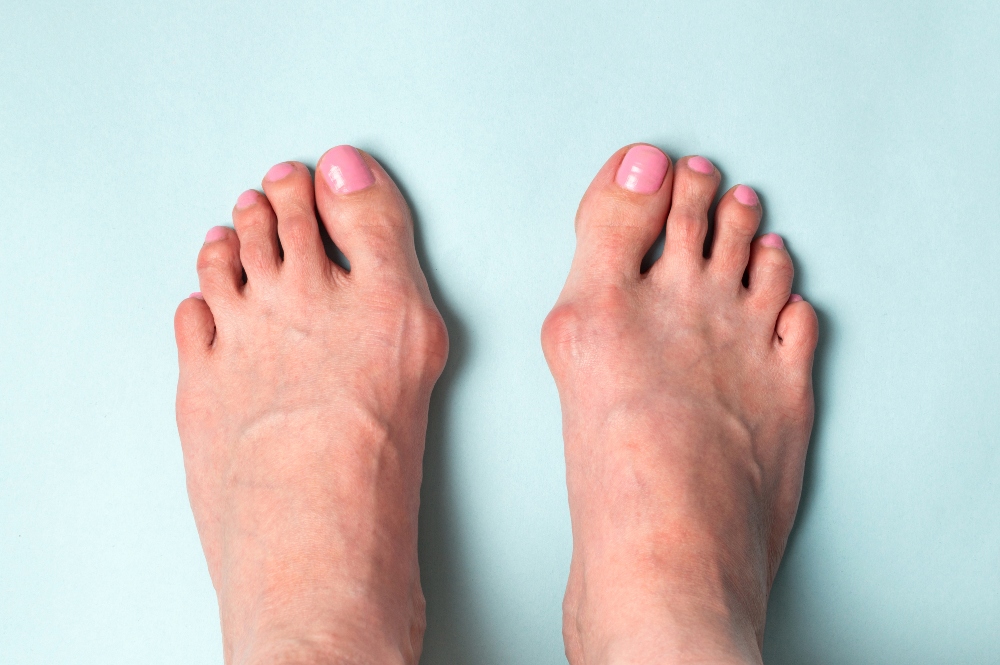Bunions are a common, but unpleasant problem. Although many people live with bunions, there are times when having them treated or removed can result in immediate relief.
What is a bunion, how do you know if you have one, and how do you prevent a bunion from getting worse? Read on as we explain the ins and outs of turning bunions into funions for your feet.
What is a Bunion?
A bunion is a deformation of the foot where the bone of your big toe pushes inward toward the other toes, creating a bump on the outside of the foot. This bump is created by the separation of the toe bone and first metatarsal. This misalignment can be symptom-free or can gradually degrade into a painful, debilitating condition.

Early Bunion Symptoms to Look Out For
Early bunion symptoms include:
- Tenderness or a burning pain that comes and goes.
- Increased calluses and corns due to friction and irritation.
- Swelling and redness, including pressure sores.
To determine if you have a bunion, ask yourself these questions:
- Looking at the base of your big toe, does it have a bump or outwardly pointed spot?
- Does your big toe lean in towards the smaller toes, even crossing over other toes?
- Does your toe ache, and occasionally have shooting pains throughout your foot?
- Does the toe feel tight, sore, or painful when you move it?
If you’ve answered yes to any of these questions, you may be experiencing bunion symptoms. A great way to further determine if your symptoms are due to bunions is to look at your family history. Although the exact cause of bunions has yet to be identified, scientists believe there is a correlation between genetics and bunion development.
Bunion Self-Care and Prevention
How to Prevent Bunions
The main thing that you can do to prevent bunions is simple; wear comfortable shoes with a wide toe box (plenty of room for the toes to wiggle around) that are flexible and have good arch support. Some shoe inserts may help provide additional cushioning and support. Of course, there isn’t much you can do about genetic predisposition, but you can let your podiatrist know if you may be predisposed to bunions.
How to Prevent Bunions From Getting Worse
Just as with prevention, treatment starts with always wearing properly fitted, supportive footwear. Using silicone or moleskin pads inside shoes to cushion the bunion can reduce friction on the bump and relieve some pain and swelling.
Taking pain relievers like naproxen or ibuprofen and icing the bunion area after being on your feet for a long time can help with swelling and pain. Reduce the amount of walking, standing, and heavy exercise that you do and be aware of anything that may put additional pressure on your feet.
When Bunion Self Care Isn’t Working
If your bunion pain is preventing you from living your life normally— say, for example, that you can’t walk more than a block without extreme pain— it’s time to put your foot down on bunion symptoms. While bunion-self care can help relieve symptoms, only surgical correction can improve your toe alignment and resolve your bunion once and for all.
Bunion surgery performed by an experienced podiatrist can mean anything from shaving the bone down to minimize the bump or cutting the bone and placing screws and plates to align the bone correctly— with many various procedures in between. Typically, the less severe your bunion is, the less invasive your treatment options.
Take Care of Your Early Bunion Symptoms
If your bunion worsens despite your best efforts, it’s time to discuss your options with an experienced podiatrist. Keep in mind, the sooner you and your podiatrist can tackle your bothersome bunions, the sooner you can find relief. Contact The Foot & Ankle Group today to schedule your appointment at one of our SWFL podiatrist locations.
Categorized in: Blog
Comments are closed